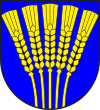S-chanf
| S-chanf | ||||||||||
|---|---|---|---|---|---|---|---|---|---|---|
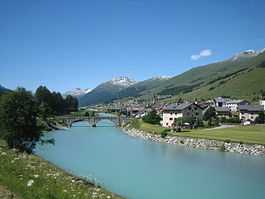 | ||||||||||
| ||||||||||
| Population | 748 (Dec 2012)[1] | |||||||||
| - Density | 5 /km2 (14 /sq mi) | |||||||||
| Area | 138.04 km2 (53.30 sq mi)[2] | |||||||||
| Elevation | 1,660 m (5,446 ft) | |||||||||
| Postal code | 7525 | |||||||||
| SFOS number | 3788 | |||||||||
| Surrounded by | Bergün/Bravuogn, Davos, Livigno (IT-SO), Madulain, Susch, Zernez, Zuoz | |||||||||
| Website | www.s-chanf.ch SFSO statistics | |||||||||
 S-chanf | ||||||||||
| Location of S-chanf
 | ||||||||||
S-chanf (![]() [ʃtɕaɱf] (help·info); German: Scanfs; Italian: Scanevo) is a municipality in the district of Maloja in the Swiss canton of Graubünden.
[ʃtɕaɱf] (help·info); German: Scanfs; Italian: Scanevo) is a municipality in the district of Maloja in the Swiss canton of Graubünden.
Localities in S-chanf municipality include Susauna, Chapella and Cinuos-chel.
Name
S-chanf is first mentioned around 1137-39 as Scaneves. In 1356 it was mentioned as Scanevo.[3] The Romansh name S-chanf is prononuced [ʃtɕanf]. The German Scanfs was official until 1943.[4] Chapella is the site of a chapel mentioned in 1209. Susauna is mentioned as Sauzana in 1285.
Geography
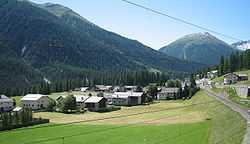
S-chanf has an area, as of 2006, of 138 km2 (53 sq mi). Of this area, 23.7% is used for agricultural purposes, while 18.6% is forested. Of the rest of the land, 0.6% is settled (buildings or roads) and the remainder (57.1%) is non-productive (rivers, glaciers or mountains).[5]
The municipality is located in the Oberengadin sub-district of the Maloja district along the Inn river and at the mouth of the Casanna pass. It consists of the linear village of S-chanf with the sections of Cinuos-chel and Susauna. The village elevation is 1,662 meters (5,453 ft).
Susauna is a hamlet on the territory of S-chanf municipality, situated on the road to Scaletta Pass, a historic international trading route.[6]
Demographics
In 1850, S-chanf had a population of 439, all of them Romansh speaking. Population declined to 402 by 1900, and rose again to 460 by 1950. S-chanf has a population (as of 31 December 2012) of 748[1]. As of 2008, 11.4% of the population was made up of foreign nationals.[7] Over the last 10 years the population has grown at a rate of 7.5% per annum.[5]
As of 2000, the gender distribution of the population was 50.7% male and 49.3% female.[8] The age distribution, as of 2000, in S-chanf is; 66 children or 10.6% of the population are between 0 to 9 years old. 46 teenagers or 7.4% are 10 to 14, and 46 teenagers or 7.4% are 15 to 19. Of the adult population, 74 people or 11.9% of the population are between 20 to 29 years old. 119 people or 19.2% are 30 to 39, 82 people or 13.2% are 40 to 49, and 73 people or 11.8% are 50 to 59. The senior population distribution is 43 people or 6.9% of the population are between 60 to 69 years old, 47 people or 7.6% are 70 to 79, there are 21 people or 3.4% who are 80 to 89, and there are 3 people or 0.5% who are 90 to 99.[7]
In the 2007 federal election the most popular party was the SVP which received 44.9% of the vote. The next three most popular parties were the FDP (24.5%), the SP (23.8%) and the CVP (5.4%).[5]
In S-chanf about 67% of the population (between age 25-64) have completed either non-mandatory upper secondary education or additional higher education (either university or a Fachhochschule).[5]
S-chanf has an unemployment rate of 1.49%. As of 2005, there were 45 people employed in the primary economic sector and about 21 businesses involved in this sector. 51 people are employed in the secondary sector and there are 6 businesses in this sector. 119 people are employed in the tertiary sector, with 32 businesses in this sector.[5]
The historical population is given in the following table:[3]
| year | population |
|---|---|
| 1781 | 423 |
| 1806 | 450 |
| 1850 | 439 |
| 1900 | 402 |
| 1950 | 460 |
| 2000 | 620 |
Languages
Most of the population (as of 2000) speaks Romansh (51.8%), with German being second most common (37.3%) and Italian being third (5.6%).[5] The population speaks either the Upper-Engadin Romansh dialect of Puter or a Bündner variety of Alemannic German. About 68% of the population could understand Romansh at least passively.
Until the mid 19th century, all residents of the village spoke Romansh, but due to increasing trade with the outside world, its usage began to decline. In 1880 about 86% spoke Romansh as a first language, in 1910 it was 92% and in 1941 it was 81%. By 1970 it had dropped to 65%, and by 2000 to 52%.
| Languages in S-chanf | ||||||
| Languages | Census 1980 | Census 1990 | Census 2000 | |||
| Number | Percent | Number | Percent | Number | Percent | |
| German | 74 | 16.02% | 129 | 25.60% | 231 | 37.26% |
| Romansh | 344 | 74.46% | 336 | 66.67% | 321 | 51.77% |
| Italian | 26 | 5.63% | 27 | 5.36% | 35 | 5.65% |
| Population | 462 | 100% | 504 | 100% | 620 | 100% |
Tourism and infrastructure
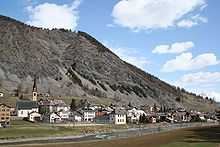
S-chanf is one of the pedestrian gateways into the Swiss National Park, as it is near the confluence of the Val Trupchun, a pedestrian only area of the park, and the Engadin. In the park, early risers may spot marmots and, high on the mountains, Steinbok (ibex). It has at least two hotels: the Aurora and the Scaletta.
S-chanf is the final destination of the "Engadin Skimarathon", a popular cross country ski race over marathon distance, which starts in Maloja.
The twin homes and barn at Nrs. 216/217 and the home with barn at Nr. 107 are listed as Swiss heritage sites of national significance.[9]
S-chanf is the home to a base of the Swiss Army, which maintains one of its antiaircraft target shooting ranges (serving also as finish area of the "Engadine Ski Marathon") in that area.
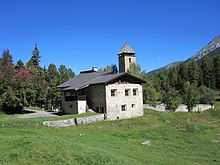
The hospice at La Chapella dates to about 1250. It was abandoned in the late 18th century, and re-opened as a youth center in 1967.
The chapel at Susauna dates to 1696, which had its own pastors from 1723 to 1834. It was abandoned in the 20th century and is now inhabited only seasonally.
References
- ↑ 1.0 1.1 Swiss Federal Statistics Office – STAT-TAB Ständige und Nichtständige Wohnbevölkerung nach Region, Geschlecht, Nationalität und Alter (German) accessed 16 September 2013
- ↑ Arealstatistik Standard - Gemeindedaten nach 4 Hauptbereichen
- ↑ 3.0 3.1 S-chanf in German, French and Italian in the online Historical Dictionary of Switzerland.
- ↑ Amtliches Gemeindeverzeichnis der Schweiz published by the Swiss Federal Statistical Office (German) accessed 23 September 2009
- ↑ 5.0 5.1 5.2 5.3 5.4 5.5 Swiss Federal Statistical Office accessed 21-Oct-2009
- ↑ (English) Hiking Switzerland pass in Graubünden on old trading route
- ↑ 7.0 7.1 Graubunden Population Statistics (German) accessed 21 September 2009
- ↑ Graubunden in Numbers (German) accessed 21 September 2009
- ↑ Swiss inventory of cultural property of national and regional significance 21.11.2008 version, (German) accessed 21-Oct-2009
| Wikimedia Commons has media related to S-chanf. |
- This article incorporates information from the equivalent article on the German Wikipedia.
External links
- http://www.s-chanf.ch
- S-chanf in German, French and Italian in the online Historical Dictionary of Switzerland.
| ||||||||||
